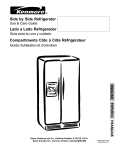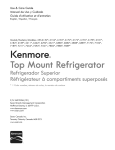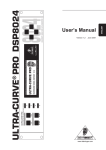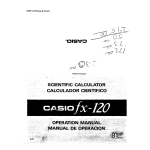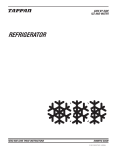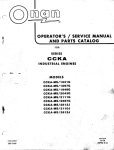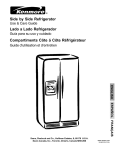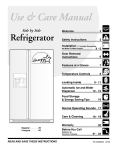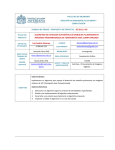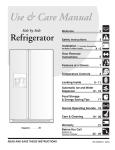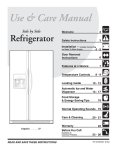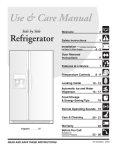Download Fisher-Price J2457 Baby Monitor User Manual
Transcript
® Side by Side Refrigerator Use & Care Guide Lado a Lado Refrigerador Gufa para su uso y cuidado Compartiments C6te d C6te Rdfrigdrateur Guide d'utilisation et d'entretien Sears, Roebuck and Co., Hoffman Estates, IL 60179 U.S.A. Sears Canada, Inc., Toronto, Ontario, Canada M5B 2B8 www.sears.com 240577300 (0301) Congratulations on your purchase of a new refrigerator! We here at Sears are very proud of our product and we are completely committed to providing you with the best service possible. Your satisfaction is our #1 priority. FOR YOUR SAFETY We know you'll enjoy your new refrigerator and Thank You for choosing our product. We hope you consider us for future purchases. PLEASE READ AND SAVE THESE INSTRUCTIONS This Owner's Guide provides specific operating instructions for your model. Use your refrigerator only as instructed in this manual. These instructions are not meant to cover every possible condition and situation that may occur. Common sense and caution must be practiced when installing, operating and maintaining any appliance. • Do not store or use gasoline, or other flammable liquids in the vicinity of this or any other appliance. Read product labels for warnings regarding flammability and other hazards. • Do not operate the refrigerator in the presence of explosive fumes. • Avoid contact with any moving parts of automatic ice maker. • Remove all staples from the carton. Staples can cause severe cuts, and also destroy finishes if they come in contact with other appliances or furniture. CHILD Please record your model and serial numbers below for future reference. This information is found on the serial plate located inside the refrigerator compartment. SAFETY Destroy or recycle the carton, plastic bags, and any exterior wrapping material immediately after the refrigerator is unpacked. Children should NEVER use these items to play. Cartons covered with rugs, bedspreads, plastic sheets or stretch wrap may become airtight chambers, and can quickly cause suffocation. Model Number: 253 PROPER or: 970 OF YOUR REFRIGERATOR OR FREEZER Serial Number: Risk of child entrapment Purchase Date: Record Serial/Model DISPOSAL Numbers Child entrapment and suffocation are not problems of the past. Junked or abandoned refrigerators or freezers are still dangerous even if they will sit for "just a few days." If you are getting rid of your old refrigerator or freezer, please follow the instructions below to help prevent accidents. ............ 2 Safety .................................................. Warranty .............................................. 2-3 3 Canada - Limited Warranty .................. Protection Agreements ........................ Installation ........................................... Door Removal Instructions ................. Features At A Glance ......................... 4 5 6-7 8 9 Temperature Controls .......................... Looking Inside ..................................... Automatic Ice & Water Dispenser ....... Front Ice and Water Filter .................... 10 11-13 14-16 17 Before you throw away your old refrigerator/freezer: Food Storage & Energy Saving Tips ... 18 Normal Operating Sounds & Sights .... 19 Care & Cleaning .................................. 20-21 Before You Call .................................... 22-25 2 • Remove doors. • Leave shelves in place so children may not easily climb inside. • Have refrigerant removed by a qualified service technician. FULL ONE-YEAR REFRIGERATOR ELECTRICAL • • • • • • • INFORMATION The refrigerator must be plugged into its own dedicated 115 Volt, 60 Hz., AC only electric outlet. The power cord of the appliance is equipped with a three-prong grounding plug for your protection against electrical shock hazards. It must be plugged directly into a properly grounded three-prong receptacle. The receptacle must be installed in accordance with local codes and ordinances. Consult a qualified electrician. Do not use an extension cord or adapter plug. Immediately repair or replace any power cord that becomes frayed or damaged. Never unplug the refrigerator by pulling on the power cord. Always grip the plug firmly, and pull straight out from the receptacle to prevent damaging the power cord. Unplug the refrigerator before cleaning and before replacing a light bulb to avoid electrical shock. Performance may be affected if the voltage varies by 10% or more. Operating the refrigerator with insufficient power can damage the compressor. Such damage is not covered under your warranty. Do not plug the unit into an outlet controlled by a wall switch or pull cord to prevent the refrigerator from being turned off accidentally. Avoid connecting refrigerator to a Ground Fault Interruptor (GFI) circuit. WARRANTY ON For one year from the date of purchase, when this refrigerator is operated and maintained according to the instructions provided in this Owner's Guide, Sears will repair this refrigerator, free of charge, if defective in material orworkmanship. FULL FIVE-YEAR REFRIGERATION WARRANTY SYSTEM ON SEALED For five years from the date of purchase, when this refrigerator is operated and maintained according to the instructions provided in this Owner's Guide, Sears will repair the sealed system (consisting of refrigerant, connecting tube, and compressor motor), free of charge, if defective in material or workmanship. The above refrigerator warranty applies only to refrigerators which are used for storage of food for private household purposes. FULL 30-DAY WARRANTY ON KENMORE REFRIGERATOR WATER FILTRATION CARTRIDGE. If this Kenmore Refrigerator Water Filtration Cartridge fails due to a defect in material or workmanship within 30 days from the date of purchase, RETURN IT TO THE NEAREST SEARS STORE IN THE UNITED STATES and Sears will replace it, free of charge. This warranty gives you specific legal rights and you may also have other rights which vary from state to state. Warranty service is available by contacting the NEAREST SEARS SERVICE CENTER/DEPARTMENT in the United States. See the back page of this manual. For warranty questions, please contact the following address: Sears, Roebuck Dept. 817WA Hoffman Estates, and Co. IL 60179 CANADA m LIMITED WARRANTY Refrigerato Sears Canada Inc., warrants every new Kenmore refrigerator What Sears will do, free of charge, in case of defect: to be free from defects in material or workmanship. The Compressor TEN (10) YEARS TEN (10) YEARS FIVE (5) YEARS The Sealed System (consisting of refrigerant, evaporator, and condenser) FIVE (5) YEARS FIVE (5) YEARS FIVE (5) YEARS ONE (1) YEAR ONE (1) YEAR ONE (1) YEAR All other parts or adjustments Normal Responsibility of the Customer The following items, since they are not manufacturing defects, are not included responsibility of the customer: 1) Damage to finish after delivery. in the warranty, but are the 2) Improper power supply, low voltage, or any defects in the house wiring system or appliance not connected to electric outlet. 3) Replacement of light bulbs. 4) Damage caused by moving the product from its original installation. 5) Service required as a result of alteration, abuse, fire, floods, or acts of God. 6) Providing adequate air circulation to the refrigerating system. 7) Proper use and care of product as listed in the customer's manual; proper setting of the controls. If any service is required under this warranty, simply call 1-800-FOR-MY-HOME (1-800-469-4663). This warranty is in addition to any statutory warranty. The above warranty covers Kenmore Refrigerators sold and operated in Canada only and shall not apply if the refrigerator is used for other than domestic purposes. Sears Maintenance Agreement Maintain the value of your Kenmore refrigerator with a Sears Maintenance SEARS CANADA INC. • Toronto, Canada • M5B 2B8 Agreement. PRINTED IN U.S.A. 4 In the U.S.A. In Canada Master Protection Agreements Maintenance Agreements Congratulations on making a smart purchase. Your new Kenmore ®appliance is designed and manufactured for years of dependable operation. But like all products, it may require preventive maintenance or repair from time to time. That's when having a Master Protection Agreement can save you money and aggravation. Your purchase has added value because you can depend on Sears HomeCentral ®for service. With over 2400 Service Technicians and access to over 900,000 parts and accessories, we have the tools, parts, knowledge and skills to ensure the pledge: We Service What We Sell. Purchase a Master Protection Agreement now and protect yourself from unexpected hassle and expense. The Master Protection Agreement also helps extend the life of your new appliance. Here's what's included in the Agreement: Your Kenmore ®appliance is designed, manufactured and tested to provide years of dependable operation. Yet any major appliance may require service from time to time. The Sears Maintenance Agreement offers you an outstanding service program, affordably priced. The Sears Maintenance Expert service by our 12,000 professional repair specialists • Unlimited service and no charge for parts and labor on all covered repairs • "No-lemon" guarantee - replacement of your covered product if more than three product failures occur within twelve months • Product replacement can't be fixed if your covered product Annual Preventive Maintenance Check at your request - no extra charge Fast help by phone - non-technical and instructional assistance on products repaired in your home, plus convenient repair scheduling Power surge protection against electrical damage due to power fluctuations Rental reimbursement if repair of your covered product takes longer than promised Once you purchase the Agreement, a simple phone call is all that it takes for you to schedule service. You can call anytime day or night, or schedule a service appointment online. Sears has over 12,000 professional repair specialists, who have access to over 4.5 million quality parts and accessories. That's the kind of professionalism you can count on to help prolong the life of your new purchase for years to come. Purchase your Master Protection Agreement todayr Some limitations and exclusions apply. For prices and additional information, call 1-800-827-6655. Sears Installation Service For Sears guaranteed professional installation of home appliances and items like garage door openers and water heaters, in the U.S.A. call 1-800-4MY-HOME ®. • Agreement Is your way to buy tomorrow's service at today's price. Eliminate repair bills resulting from normal wear and tear. Provides for non-technical and instructional assistance. Even if you don't need repairs, provides an annual Preventive Maintenance Check, at your request, to ensure that your appliance is in proper running condition. Some limitations apply. For information concerning Sears Canada Maintenance Agreements, call 1-800-361-6665 This Owner's Guide provides specific operating instructions for your model. Use the refrigerator only as instructed in this Use & Care Manual. Before starting the refrigerator, follow these important first steps. LOCATION • Choose a place that is near a grounded electrical outlet. Do Not use an extension cord or an adapter plug. • If possible, place the refrigerator out of direct sunlight and away from the range, dishwasher or other heat sources. • The refrigerator must be installed on a floor that is level and strong enough to support a fully loaded refrigerator. • Consider water supply availability for models equipped with an automatic ice maker. To Install Toe Grille: 1. Open freezer and fresh food compartment doors. 2. Line up toe grille at base of refrigerator, making sure the four bottom tabs are INSTALLATION Cabinet resting through holes at base of cabinet. 3. Installation Clearances • Allow the following clearances for ease of installation, proper air circulation, and plumbing and electrical connections: Sides & Top Back DOOR LEVELING All four corners of your refrigerator must rest firmly on a solid floor. Your refrigerator is equipped with adjustable front rollers to help level your unit. To ensure proper door seal and assist door closing, the refrigerator should be tilted 1/4" (6 mm), front to back. To Level Your Refrigerator: 3/8" 1" OPENING 1. 2. Your refrigerator should be positioned to allow easy access to a counter when removing food. For best use of drawers and freezer baskets, the refrigerator should be in a position where both the refrigerator and freezer doors can be fully opened. TOE GRILLE INSTALLATION Starting from left side of toe grille, press in on first top tab using your thumb and push toe grille forward until it snaps in place. Continue this process until all tabs aresnapped in place and toe grille is secured to refrigerator. Remove toe grille. (See "To Remove Toe Grille".) Use flat-blade screwdriver or 3/8" socket wrench to adjust front rollers. / REMOVAL To Remove Toe Grille: 1. 2. Open freezer and fresh food compartment doors. Working from left side of toe grille, slip your fingers between top of toe grille and cabinet. Gently pull forward untilfirst set of tabs are free. Slide your hand down past the free tabs and pull forward again until the second set of tabs are free. Continue this process until all tabs are free and the toe grille can be removed. (See graphic at top of page in right column.) . 6 Check both doors to be sure seals touch cabinet on all four sides. Before Installing The Water Supply Line, You Will Need • • Basic Tools: adjustable wrench, flat-blade screwdriver, and Phillips TM screwdriver Access to a household cold water line with water pressure between 20 and 10O psi. • A water supply line made of 1Ainch (6.4 mm) OD, copper tubing. To determine the length of copper tubing needed, you will need to measure the distance from the ice maker inlet valve at the back of the refrigerator to your cold water pipe. Then add approximately 7 feet (2.1 meters), so the refrigerator can be moved out for cleaning (as shown). A shutoff valve to connect the water supply line to your household water system. DO NOT use a self-piercing type shutoff valve. • • A compression nut and ferrule (sleeve) for connecting the water supply line to the ice maker inlet valve. To Connect Water Supply Line To Ice Maker Inlet Valve 1. 2. Disconnect refrigerator from electric power source. Place end of water supply line into sink or bucket. Turn ON water supply and flush supply line until water is clear. Turn OFF water supply at shut off valve. 3. Unscrew plastic cap from water valve inlet and discard cap. 4. Slide brass compression nut, then ferrule (sleeve) onto water supply line, as shown. 5. Push water supply line into water valve inlet as far as it wilt go (1Ainch). Slide ferrule (sleeve) into valve inlet and finger tighten compression nut onto valve. Tighten another half turn with a wrench; DO NOT over tighten. 6. With steel clamp and screw, secure water supply line to rear panel of refrigerator as shown. 7. Coil excess water supply line (about 2V2turns) behind refrigerator as shown and arrange coils so they do not vibrate or wear against any other surface. 8. Turn ON water supply at shutoff valve and tighten any connections that leak. 9. Reconnect refrigerator to electrical power source. 10. To turn ice maker on, lower wire signal arm (see ice maker front cover for ON/OFF position of arm). DOOR REMOVAL INSTRUCTIONS: If it is necessary to move the refrigerator through narrow doorways, follow these steps to remove the doors. iiill 1. Disconnect electrical supply. 2. Open both doors, then remove toe grille. 3. Close doors. To Remove Refrigerator Ooor: 1. Remove top hinge cover screw on refrigerator door and remove cover. 2. Trace around hinge with soft lead pencil. This will make it easier to realign ...... doors when they are replaced. 3. Remove top hinge and lift refrigerator door off bottom hinge pin. Set door aside. 4. Remove bottom hinge, if necessary. 5. Reverse this procedure to reinstall refrigerator door. To Remove Freezer Ooor: 1. Disconnect water line coming from lower hinge of freezer door at connection located under front of freezer: Press outer ring against face of fitting, then pull to remove tube. 2. Remove top hinge cover screw on freezer door and remove cover. 3. Disconnect harness connector top hinge: yourthumbson flat sides of wiring each connector and bendplug bothat parts back place and forth, then with firm grasp, pull both pieces apart. 4. Tracearoundhingewithsoftleadpencil. Thiswillmakeiteasiertorealign doors when they are replaced. Remove top hinge, allowing wiring harness to pull through hinge and lift freezer door off of bottom hinge pin. Lay door down flat to avoid kinking water line. Remove bottom hinge, if necessary. Reverse this procedure to reinstall freezer door. 5. 6. 7. When both doors have been reinstalled, connect water line by inserting tube and push until mark touches face of fitting, replace toe grille and plug in electrical power cord. Turn both temperature controls to center position. Adjust settings as necessary. 8 Freezer and Refrigerator SpilIProof'" g Sheif Controls Filter t ®;® , Door r Bin Meat Keeper and Cover Smell items )lllProof'" Fixed Shelf Special item Largq Bottle Retainer Largq and Cover Door Bin Toe Grille Features may vary according to model COOL DOWN PERIOD To ensure safe food storage, allow the refrigerator to operate with the doors closed for at least 8 to 12 hours before loading it with food. REFRIGERATOR & FREEZER TEMPERATURE ADJUSTMENT CONTROLS • After 24 hours, adjust the controls as needed. Adjust temperatures gradually; move the knob in small increments, allowing the temperature to stabilize. • • For colder temperatures, turn the knob towards Colder. For warmer temperatures, turn the knob towards Cold. To maintain temperatures, a fan circulates air in the refrigerator and freezer compartments. For good circulation, do not block cold air vents with food items. R-ash_ed Refrigerator & Freezer Controls (Features may vary according to model.) TEMPERATURE ADJUSTMENT GUIDE If Fresh Food Compartment Is Too Warm Turn Fresh Food Control Slightly Towards Colder. If Fresh Food Compartment Is Too Cold Turn Fresh Food Control Slightly Towards Cold. If Freezer Compartment Is Too Warm Turn Freezer Control Slightly Towards Colder. If Freezer Compartment Is Too Cold Turn Freezer Control Slightly Towards Cold. * To Turn Refrigerator Off Turn Freezer and Fresh Food Controls To O. 10 TIP-UP SHELF (SOME MODELS) ATip-Up shelf in the freezer section allows tall items to be easily stored. CANTILEVER SHELF ADJUSTMENT Cantilever Glass Shelf Refrigerator shelves are easily adjusted to suit individual needs. Before adjusting the shelves, remove all food. Cantilever shelves are supported at the back of the refrigerator. TO adjust O cantilever shelves: Lift front edge up. Pull shelf out. Replace the shelf by inserting the hooks at rear of the shelf into the wall bracket. Lower the shelf into the desired slots and lock into position. SpillProoF Mglass shelves (some models) catch and hold accidental spills. In some models, the SpillProoF Mshelves slide out for easy access to food and for fast cleaning. The shelves slide out independently of their mounting brackets. Just pull the front of the shelf forward. Shelves can be extended as far as the stopper will allow but are not removable from their mounting brackets. Cantilever 11 Sliding Glass Shelf DOOR STORAGE TALL BOTTLE Door bins and shelves are provided for convenient storage of jars, bottles, and cans. Frequently used items can be quickly selected. Some models have door bins that can accommodate gallon-sized plastic drink containers and economy-sized jars and containers. Some bins are adjustable for maximum storage capacity. RETAINER (SOME MODELS) The Tall Bottle Retainer keeps tall containers in the bin from falling forward when opening or closing the refrigerator door. To install, hold the retainer at the top, and slide it over the outside wall of the bin, as shown in the diagram. The Tall Bottle Retainer works best with a Bin Snugger. The dairy compartment, which is warmer than the general food storage section, is intended for short term storage of cheese, spreads, or butter. Tall Bottle Retainer (left) and Bin Snugger (right) SPECIAL ADJUSTABLE DOOR BINS Some models have adjustable door bins that can be moved to suit individual needs. ITEM RACK (SOME MODELS) The innovative design of the Special Item Rack allows you to store a six-pack of 12 ounce drink cans, a bottle of wine, a two-liter soft drink bottle, or a carton of eggs. The Special Item Rack mounts on the left side of your refrigerator. To install, just slide the Special Item Rack onto any shelf as shown in the drawing. To move door bins 1. 2. Lift bin straight up. Remove bin. 3. 4. Place bin in desired position. Lower bin onto supports until locked in place. Special Item Rack 12 CRISPERS (SOME MODELS) MEAT KEEPER The crispers, located under the bottom refrigerator shelf, are designed for storing fruits, vegetables, and other fresh produce. Wash items in clear water and remove excess water before placing them in the crispers. Items with strong odors or high moisture content should be wrapped before storing. Crisper HUMIDITY CONTROL (SOME MODELS) Some models are equipped with a Meat Keeper. Meat Keeper temperatures can be adjusted by sliding the Meat Keeper Temperature Control in either direction. Use this pan for short term storage of bulk meat items. If meats are to be kept longer than one or two days, they should be frozen. The Meat Keeper is fixed and cannot be moved up or down. If fruits or vegetables are to be stored in the Meat Keeper, set the Meat Keeper Temperature Control to a warmer setting to prevent freezing. [ Drawer (SOME MODELS) Meat Keeper with Temperature Control The Humidity Control, present on some models with crisper drawers, allows you to adjust the humidity within the crisper. This can extend the life of fresh vegetables that keep best in high humidity. WINE RACK (SOME MODELS) The wine rack stores bottles of wine, or single two-liter plastic bottles of juice or soda pop. To install, slide the Wine Rack onto the shelf with the curve facing in. To remove, slide the Wine Rack out. Install on either side of shelf. Crisper Humidity Control DELl DRAWER (SOME MODELS) Some models are equipped with a Deli Drawer for storage of luncheon meats, spreads, cheeses, and other deli items. Wine Rack 13 v Ice and Water Dispenser Panel (features may vary according to model) POLAR FREEZE To freeze food at a faster rate to preserve freshness, push the Touch Pad t feature.A green light will appear above the Touch Pad. Push the Touch Pac RAPID ICE To increase ice production for special occasions, such as parties, push the Touch Padl activate this feature. A green light will appear above the Touch Pad. Push the Touch seconds to deactivate. CUBE Press the CUBE Touch Padtto against ICE dispensing CRUSH padd e'_"O Press the CRUSH Touch Pad@to against ICE dispensing paddle u for 3-5 seconds to activate this ]in for 3-5 seconds to deactivate. for 3-5 seconds to Q again for 3-5 get cubed ice. A green light will appear above the Touch Pad. Press glass as far up as possible to catch all ice. get crushed ice. A green light will appear above the Touch Pad. Press glass as far up as possible to catch all ice. LIGHT Press the LIGHT Touch Pad O to turn on dispenser light. The light also turns on automatically water is dispensed. Replace hg"ht bulb with an appliance bulb of the same wattage. FILTER RESET The FILTER RESET indicator light above the Touch Pad O following filter light indications are: Green The filter is still operating within its specified Amber The filter has reached purchase Red a replacement approximately will light up each time the dispenser is used. The life cycle. 80% of its useful life. This is the recommended time to filter. ] The filter is 100% used up. Change the filter as soon as possible. After the filter cartridge has been changed, press and hold the FILTER RESET Touch Pad O NOTE: The Green, Bed, and Amber lights will flash when reset is completed. LOCK when ice and/or The Ice & Water Dispenser can be locked for 10-15 seconds. out to prevent unwanted use. To Lock Out Press the LOCK Touch Pad O To Unlock Press the LOCK Touch Pad Q for 3-5 seconds. A Red light will appear above the Touch Pad. for 3-5 second until the Bed light above the Touch Pad goes out. WATER To operate the water dispenser, press a glass against_e WATER dispensing paddle O" To stop dispensing water, pull the glass away from the dispensing paddle U " Dispensed water is not celdTFor colder water, add crushed ice or cubes before dispensing water. A drip tray located at the base of the dispenser catches small spills and allows them to evaporate. This drip tray is removable and dishwasher safe. Do not pour water and excess ice in this area because there is no drain. 14 ICE AND WATER DISPENSER FEATURES The ice and water dispenser conveniently dispenses chilled water, and ice cubes or crushed ice, depending on the model. To operate the ice dispenser, select the ice option desired using the touchpad. Press a glass against the dispensing paddle as far up as possible to catch all ice. To stop dispensing ice, pull glass away from dispensing paddle. Do not remove the glass until the ice has completely dispensed. (Complete instructions for the dispenser operation are attached to the inside of the freezer door.) How the Water Dispenser Works The water tank, located behind the drawers in the refrigerator compartment, automatically fills as water is dispensed. For proper dispenser operation, the recommended supply water pressure should fall between 20 psi and 100 psi. After the refrigerator is connected to the water supply, fill the water tank by drawing one glass of water. It may take about 11/_minutes after activating the dispenser paddle before water begins to fill this first glass. Continue flushing the system for 3 minutes to rid the tank and plumbing connections of any impurities. The water dispenser has a built in shutoff device that will stop the water flow after 3 minutes of continuous use. Simply release the dispenser paddle to reset the shutoff mechanism. Hew the Ice Dispenser Works The ice maker and container are located in the top of the freezer compartment. After the refrigerator is installed properly and has cooled for several hours, the ice maker can begin making ice within 24 hours. Air in new plumbing lines may cause the ice maker to cycle two or three times before making a full tray of ice. To begin ice production, lower the wire signal arm to the "down" or ON position. With no usage it will take approximately 2 days to fill the ice container. The ice maker turns off automatically when the ice container becomes full. To stop the ice maker, lift the wire signal arm until it clicks, and locks in the "up" or OFF position. Because of new plumbing connections, the first production of ice cubes may be discolored or have an odd flavor. These should be discarded until the cubes made are free of discoloration and taste. ICE DISPENSER • • • TIPS Ice cubes stored too long may develop an odd flavor. Empty the ice container and ensure that the wire signal arm is in its "down" or ON position. The ice maker will then produce more ice. Occasionally shake the ice container to keep ice separated. Keep the wire signal arm in its "up" or OFF position until the refrigerator is connected to the water supply or whenever the water supply is turned off. If a large quantity of ice is needed at one time, it is best to remove cubes directly from the ice container. The following sounds are normal when the ice maker is operating: • Motor running • Running water • Ice dropping into ice container • Stop the ice maker when cleaning the freezer and during vacations. • Water valve opening or closing • If the ice maker will be turned off for a long period of time, turn the • Ice loosening from tray water supply valve to the closed position. 15 CLEANING THE ICE DISPENSER Do not use the Clean the dispenser and ice container at regular intervals, particularly before you take a vacation or move, or if the ice dispenser sticks. 1. Stop ice production by lifting the wire signal arm to the "up" or OFF position. 2. Remove ice container by lifting up and out. Empty and carefully clean the container with mild detergent. Rinse with clear water. Do not use harsh or abrasive cleaners. Allow ice 3. 4. \ \ container to dry completely before replacing in the freezer. Remove ice chips and clean the shelf and chute that supports the ice container. Replace the ice container. Lower the wire signal arm on the ice maker to the "down" or ON position and the ice maker will resume production. Remove and empty the ice storage bin if: 1. An extended power failure (one hour or longer) causes ice cubes in the ice storage bin to melt and freeze together and jam the dispenser mechanism. 2. The ice dispenser is not used frequently. Ice cubes will freeze together in the bin and jam the dispenser mechanism. Remove the ice storage bin and shake to loosen the cubes. NEVER use an ice pick or similar sharp instrument to break up the ice. This could damage the ice storage bin and dispenser mechanism. 16 Kenmore Ice and Water Front Filter (some models) NOTE: If you purchased a refrigerator with a Kenmore Ice and Water front filter, please read the following use and care information. This ice and water filter system filters water to your ice maker and water dispenser. It is located in the upper right front corner of the fresh food compartment. System Startup: Water supply does not need to be turned off, however, do not use ice and water dispenser while installing filter. The filter cartridge has already been installed in the filter housing at the factory. Refer to the How The Water Dispenser Works section to properly fill the system with water. Changing the Filter: Water conditions vary throughout the world, but changing the water filter every 6 - 9 months normally will ensure the highest possible water quality. The Filter Status light wilt turn red after approximately 400 gallons of water has flowed through the ice and water dispenser. Also, if the filter has been in a refrigerator that has not been in use for awhile (during moving for example), change the filter before reinstalling the refrigerator. The dispenser system will also operate without filtration (with filter cartridge removed and bypass installed). To change filter: It is not necessary to turn the water supply off to change the filter. 1. 2. Order new filter cartridges through the dealer where you bought the refrigerator, or contact the Sears PartsDirect at 1-800366-PART. It might be good to order some filter carfridges when you first install your refrigerator. Be sure to ask for the Kenmore replacement cartridge 46 9911. Filter System NGFC 2000 with the Kenmore cartridge FC The Kenmore Ice and Water 100 is tested and cerfified by NSF International, the nationally recognized and respected, not for profit, certification organization for public health safety. The Kenmore Filter system is tested and certified to ANSI/NSF Standards 42 and 53. See performance data sheet for specifications. This system should not be used on water that is microbiologically unsafe or with water of unknown quality unless the water has been adequately disinfected before or after traveling through the filtration system. Set ice maker wire signal arm to the OFF (up) position (See illustration on page 15). Push the Filter Release Button, located to the right of the filter cartridge, to release the filter from the housing. To minimize the possibility of the filter falling out of the housing during removal, it would be best to hold the filter as it moves out toward you. 3. 4. Pull the old filter cartridge straight out of the housing. Discard the old filter. 5. Remove the new filter cartridge from the packaging and insert into the filter housing the same way the old one came out. When the cartridge is almost in, you will feel it stop against the clip assembly in the back of the housing. The clip assembly holds the filter cartridge firmly in place. At this point, you will need to push firmly until the cartridge snaps fully in place. When completely in place, the front of the filter cartridge wilt be flush with the front of the housing. Set the ice maker wire signal arm to the ON (down) position. Fill a glass with water. As you are doing this, check for leaks at the filter housing. There will be noticabte spurts and sputters as the system pushes the air out through the system and out the dispenser nozzle. This is normal. After you have run one glass of water, continue to flush the system for approximately 3 minutes to assure that the purest water possible is stored in the water storage tank. 6. 7. 8. 9. _ Rated Capacityflow - 400 Rated service - .5 gallons GPM • Maximum Rated Pressure - 100 PSI • Maximum Operating Temp. - 100° F 17 FOOD STORAGEIDEAS Fresh Food Storage • The fresh food compartment should be kept between 34 ° F and 40 ° F with an optimum temperature of 37 ° F. • Avoid overcrowding the refrigerator shelves. This reduces the circulation of air around the food and results in uneven cooling. Fruits and Vegetables • Storage in the crisper drawers traps moisture to help preserve the fruit and vegetable quality for longer time periods. Meat • Raw meat and poultry should be wrapped securely so leakage and contamination of other foods or surfaces does occu r. not Frozen Food Storage • The freezer compartment should be kept at 0 ° F or lower. • A freezer operates most efficiently when it is at least 2/3 full. Packaging Foods for Freezing • • • To minimize dehydration and quality deterioration, use aluminum foil, freezer wrap, freezer bags or airtight containers. Force as much air out of the packages as possible and seat them tightly. Trapped air can cause food to dry out, change color, and develop an off-flavor (freezer burn). Wrap fresh meats and poultry with suitable freezer wrap prior to freezing. Do not refreeze meat that has completely thawed. Loading the Freezer • Avoid adding too much warm food to the freezer at one time. This overloads the freezer, slows the rate of freezing, and can raise the temperature of frozen foods. • Leave a space between the packages, so cold air can circulate freely, allowing food to freeze as quickly as possible. • Avoid storing hard-to-freeze foods such as ice cream and orange juice on the freezer door shelves. These foods are best stored in the freezer interior where the temperature varies less. ENERGY • • • • • • • SAVING IDEAS Locate the refrigerator in the coolest part of the room, out of direct sunlight, and away from heating ducts or registers. Do not place the refrigerator next to heat-producing appliances such as a range, oven, or dishwasher. If this is not possible, a section of cabinetry or an added layer of insulation between the two appliances will help the refrigerator operate more efficiently. Level the refrigerator so that the doors close tightly. Refer to this Use & Care Manual for the suggested temperature control settings. Periodic cleaning of the condenser will help the refrigerator run more efficiently. See the Care and Cleaning Charton page 20. Do not overcrowd the refrigerator or block cold air vents. Doing so causes the refrigerator to run longer and use more energy. Cover foods and wipe containers dry before placing them in the refrigerator. This cuts down on moisture build-up inside the unit. Organize the refrigerator to reduce door openings. Remove as many items as needed at one time and close the door as soon as possible. 18 UNDERSTANDING HEAR THE SOUNDS YOU MAY A. Your new high-efficiency refrigerator may make unfamiliar sounds. These are all normal sounds and soon will Evaporator The flow of refrigerant through the evaporator may create a boiling or gurgling sound. B. Evaporator Fan You may hear air being forced through the refrigerator by the evaporator fan. Also, you will feel warm air being pushed out the front of the refrigerator from under the Toe Grille. become familiar to you. They also indicate your refrigerator is operating as designed. Hard surfaces, such as vinyl or wood floors, walls, and kitchen cabinets may make sounds more noticeable. Listed below are descriptions of some of the most common sounds you may hear, and what is causing them. C. Defrost Heater During defrost cycles, water dripping onto the defrost heater may cause a hissing or sizzling sound. After defrosting, a popping sound may occur. D. Automatic Ice Maker If your refrigerator is equipped with an automatic ice maker, you wilt hear ice cubes falling into the ice bin. E. Cold Control & Automatic Defrost Control These parts can produce a snapping or clicking sound when turning the refrigerator on and off. F. Condenser Fan You may hear air being forced through the condenser by the condenser fan. G. Compressor Modern, high-efficiency compressors operate much faster than older models. The compressor may have a high-pitched hum or pulsating sound. H. Water Valve If your refrigerator is equipped with an automatic ice maker, you will hear a buzzing sound as the water valve opens to fill the ice maker during each cycle. L Drain Pan (not removable) J. 19 You may hear water running into the drain pan during the defrost cycle. Condenser Keep your refrigerator and freezer clean to prevent odor build-up. Wipe up any spills immediately and clean both sections at least twice a year. Never use metallic scouring pads, brushes, abrasive cleaners or strong alkaline solutions on any surface. De net wash any removable parts in a dishwasher. Always unplug the electricalpower cord from the wall outlet before cleaning. Care & Cleaning Part Chart Cleaning Agents Tips and Precautions Interior/Door Liner • • Soap and water Baking soda and water Use 2 tablespoons of baking soda in 1 quart of warm water. Be sure to wring excess water out of sponge or cloth before cleaning around controls, light bulb or any electrical part. Door Gaskets • Soap and water Wipe gaskets with a clean soft cloth. Drawers/Bins • Soap and water Do not wash any removable items (bins, drawers, etc.) in dishwasher. Glass Shelves • • Soap and water Glass cleaner Allow glass to warm to room temperature before immersing in warm water. • Mild liquid sprays Toe Grille • • • Soap and water Mild liquid sprays Vacuum attachment Vacuum dust from front of toe grille. Remove toe grille (See illustration on page 6). Vacuum backside and wipe with sudsy cloth or sponge. Rinse and dry. Exterior and Handles • Soap and water Do not use commercial household cleaners, ammonia, or alcohol to clean handles. = = = Soap and water Ammonia Stainless Steel Cleaners Clean stainless steel front and handles with soapy water. Use ammonia on stubborn spots. Use a non-abrasive stainless steel cleaner. These cleaners can be purchased at most home improvement or major department stores. • Vacuum attachment Use the dusting tool attachment on your vacuum to remove dust build-up on the condenser coils (see item "J" in illustration on page 19 for location). Exterior and Handles (Stainless Steel Models Only) Condenser Coils 2O REPLACING 1. 2. 3. 4. 5. 6. LIGHT BULBS Unplug refrigerator. Wear gloves as protection against possible broken glass. Remove light cover, if necessary. Unscrew and replace old bulb with an appliance bulb of the same wattage. Replace light cover, if necessary. Remember to plug the refrigerator back in. Refrigerator Crisper Light Replacement (Some Models) Light Replacement Freezer Light Replacement Vacation and Moving Tips Short Vacations Long Vacations Moving • • • Leave refrigerator operating during vacations of 3 weeks or less. Use all perishable items from refrigerator compartment. Turn automatic ice maker off, even if you will only be gone for a few days. • • • • • Remove all food and ice if you will be gone one month or more. Turn controls to "O" (the OFF position) and disconnect power. Turn off automatic ice maker and turn water supply valve to closed position. Clean interior thoroughly. Leave both doors open to prevent odors and mold build-up. Block doors open if necessary. • Remove all food and ice. • • • If using handcart, load from side. Adjust rollers all the way up to protect them during sliding or moving. Pad cabinet to avoid scratching surface. 21 PROBLEM CAUSE CORRECTION RUNNING OF REFRIGERATOR Compressor does not run. • Freezer control is set to "O". • Refrigerator is in defrost cycle. • Plug at wall outlet is disconnected. House fuse blown or tripped circuit breaker. Power outage. • • • • Refrigerator runs too much or too long. • • • • • • • Compressor goes off and on frequently, TEMPERATURES ARE • • • Set freezer control See Temperature Controls section. This is normal for a fully automatic defrost refrigerator. The defrost cycle occurs periodically, lasting about 30 minutes. Ensure plug is tightly pushed into outlet. • Check/replace fuse with a 15 amp time-delay fuse. Reset circuit breaker. • Check house lights. Call local Electric Company. Room or outside weather is hot. Refrigerator has recently been disconnected for a period of time. Automatic ice maker is operating. Doors are opened too frequently or too long. Refrigerator/freezer door may be slightly open. • it's normal for the refrigerator to work longer under these conditions. It takes 8-12 hours for the refrigerator to cool down completely. Freezer control is set too cold (control found in refrigerator section). Refrigerator/freezer gasket is didy, worn, cracked, or poorly fitted. Condenser is dirty. • Thermostat keeps the refrigerator at a constant temperature. • This is normal Refrigerator goes on and off to keep temperature constant. • • • • • • Ice maker operation causes refrigerator to run slightly more. Warm air entering the refrigerator causes it to run more. Open doors less often. Ensure refrigerator is level Keep food and containers from blocking door. See PROBLEM section OPENING/CLOSING OF DOORS/DRAWERS. Set refrigerator control to warmer setting until refrigerator temperature is satisfactory. Allow 24 hours for temperature to stabilize. Clean or change gasket. Leaks in door seal will cause refrigerator to run longer in order to maintain desired temperatures. Clean condenser. See Care & Cleaning Chart in Care and Cleaning section. TOO COLD Freezer temperature too cold. Refrigerator temperature is satisfactory. • Freezer control is set too cold. • Set freezer control to a warmer setting. Allow 24 hours for temperature to stabilize. Refrigerator temperature too cold. Freezer temperature is satisfactory. • Refrigerator control is set too cold. • Set refrigerator control to a warmer setting. Allow 24 hours for temperature to stabilize. Food stored in drawers freezes, • Refrigerator control is set too cold. • See solution above. Food stored in Meat Keeper freezes (some models), • Meat Keeper Temperature Control set too cold. • Adjust Meat Keeper Temperature Control to a lower setting. (Meat should be stored at a temperature just below the freezing point for maximum fresh storage time. It is normal for ice crystals to form due to the moisture content of meat.) 22 PROBLEM TEMPERATURES CAUSE ARE CORRECTION TOO WARM Freezer/Refrigerator temperature Is too warm. • • • Doors are opened too frequently or too long. Doer is slightly open. • Condenser is dirty. • Freezer temperature is too warm. Refrigerator temperature is satisfactory. = Freezer control is set too warm. = Set freezer control to a colder setting. Allow 24 hours for temperature to stabilize. Refrigerator temperature is too warm. Freezer temperature is satisfactory. = Refrigerator control is set too warm. = Set refrigerator control to a colder setting. Allow 24 hours for temperature to stabilize. Temperature in the Meat Keeper is too warm (some models). = Meat Keeper Temperature Control is set too warm. = Adjust Meat Keeper Temperature setting. WA TEn/MOISTURE/FROST Moisture collects on inside of refrigerator walls. INSIDE Water collects in bottom of drawer, AUTOMATIC Ton Weather is hot and humid. • • Door is slightly open. • • Door is opened too often or too long. Open containers. • The rate of frost buildup and internal sweating increases. See PROBLEM section OPENING/CLOSING OF DOORS/DRAWERS. Open door less often. • Keep containers covered. Vegetables contain and give off moisture, • It is not unusual to have moisture on the bottom side of the cover. • Move humidity control (some models) to lower setting. • Dry items before putting them in the drawer. Water collecting in bottom of drawer is normal This is normal in humid weather. When humidity is lower, the moisture should disappear. See PROBLEM section OPENING/CLOSING OF DOORS/DRAWERS. • • WA TEn/MOISTURE/FROST Moisture collects on outside of refrigerator between doors. Control to a colder • • Water collects on bottom side of drawer cover, REFRIGERA • Warm air enters the refrigerator whenever the door is opened. Open the door less often. See PROBLEM section OPENING/CLOSING OF DOORS/DRAWERS. Clean condenser. See Care & Cleaning Chart in Care and Cleaning section. Washed vegetables and fruit drain while in the drawer, OUTSIDE REFRIGERA Ton • Weather is humid. • • Door is slightly open, causing cold air from inside refrigerator to meet warm air from outside. • • Ice maker wire signal arm is in the "up" or OFF position. Household water line valve is not open. Freezer is not cold enough. • Move wire signal arm to the "down" or ON position. • Turn on household water line valve. • Saddle valve on cold water pipe is clogged or restricted by foreign material Check to see if the water dispenser is dispensing water. • See PROBLEM section TEMPERATURES ARE TOO WARM. Turn off household water line valve. Remove valve. Ensure that valve is not a self-piercing saddle valve. Clean valve. Replace valve if necessary. If not, the ice & water filter cartridge is dogged or restricted by foreign material, and must be replaced. or ICE MAKER Ice maker is not making any ice. • • • • 23 • PROBLEM AUTOMA TIC ICE MAKER Ice maker is not making enough ice. CAUSE CORRECTION (CONTINUED) • Ice maker is producing less ice than you expect. • • Freezer is not cold enough. • • Household water line valve is not completely open. Check to see if water dispenser is dispensing slower than normal. • • ice maker should produce approximately 4 - 5 pounds of ice every 24 hours. Extra Iceshould produce up to 8 pounds of ice every 24 hours. See PROBLEM section TEMPERATURES ARE TOO WARM. Turn on household water line valve. If it is, replace the ice & water filter cartridge. Ice maker will not stop making ice. • Ice maker wire signal arm is being held down by some item in the freezer, • Move item and release wire signal arm. Remove any ice cubes that are frozen together over the wire signal arm. Ice maker is not separating the ice cubes, • Ice cubes are not being used frequently enough. lee cubes are hollow or smaller than normal. • Remove and shake ice container to separate cubes. • The ice & water filter cartridge may be clogged. Replace filter cartridge. • Cover foods tightly. Discard stale ice. Ice maker will produce fresh supply. • • lee has picked up odor or flavor from strong food stored in refrigerator or freezer. Water running to ice maker has poor taste or odor. Ice not used frequently enough. Add filter to water supply line. Consult a water purifying company. Discard stale ice. • Ice storage container is empty. • • Freezer temperature is set too warm. • • Household water line valve is not open. • Freezer door is not closed. Ice dispensing arm has been held in for more than 4-5 minutes. • • • Ice has bad odor and taste. • • • ICE DISPENSER Dispenser will not dispense ice. Ice dispenser is jammed. • • • Ice has melted and frozen around auger due to infrequent use, temperature fluctuations, and/or power outages. Ice cubes are jammed between ice maker and back of ice container. Ice cubes are frozen together. lee cubes are hollow or smaller than normal. 24 When the first supply of ice is dropped into the container, the dispenser should operate. Turn freezer control to a higher setting so that ice cubes will be made. When first supply of ice is made, dispenser should operate. Open household water line valve. Allow sufficient time for the ice to be made. When ice is made, the dispenser should operate. Ensure freezer door is closed. Motor is overloaded. Motor overload protector will reset in approximately 3 minutes. Ice can then be dispensed. Remove ice container, thaw, and empty the contents. Clean container, wipe dry, and replace in proper position. When new ice is made, dispenser should operate. Remove ice cubes that are jamming the dispenser. Use the dispenser often so that cubes do not freeze together. The ice & water filter cartridge could be clogged. Replace the filter cartridge. Dispensing system operates best at 20 - 100 psi water pressure. Well water pressures should fall within this range. PROBLEM WATER CAUSE DISPENSER Dispenser will not dispense water, • Household water line valve is not open. Freezer door is not closed. Ice & water filter cartridge is clogged. • Water has been in the tank for a period of time. Unit not properly connected to cold water line. Tubing used in the household water supply and installation may affect water taste and odor. Water has a high mineral content. • • Contact water treatment plant for help. Cut-off and cut-on pressures are too low (well systems only). Reverse osmosis system is in regenerative phase. • Have someone turn up the cut-off and cut-on pressure on the water pump system (well systems only). It is normal for a reverse osmosis system to be below 20 psi during the regenerative phase. • interior needs to be cleaned. • • Food with strong odors is in refrigerator. • See Care & Cleaning Chart in Care and Cleaning section. Cover food tightly. Door was closed too hard, causing other door to open slightly. Refrigerator is not level It rocks on the floor when moved slightly. Refrigerator is touching a wall or cabinet. • Close both doors gently. • Ensure floor is level and solid, and can adequately support the refrigerator. Contact a carpenter to correct a sagging or sloping floor. Ensure floor is level and solid, and can adequately support the refrigerator. Contact a carpenter to correct a sagging or sloping floor. Food is touching shelf on top of drawer. Track that drawers slide on is dirty. • Keep less food in drawer. • Clean drawer, rollers, and track. See Care & Cleaning Chart in Care and Cleaning section. • Light bulb is burned out. • • Light switch is stuck. • • No electric current is reaching refrigerator. • See Replacing Light Bulbs in Care and Cleaning section. Light switch is located on side of refrigerator and freezer liners. See PROBLEM section RUNNING OF REFRIGERATOR. • • Water has an odd taste and/or odor. • Water pressure is extremely low. • • ODORS • • • • • Open household water line valve. See PROBLEM section ICE MAKER IS NOT MAKING ANY ICE. Ensure that freezer door is closed. Replace filter cartridge. Draw and discard 10 - 12 glasses of water to freshen the supply and completely rinse out the tank. Connect unit to cold water line that supplies water to the kitchen faucet. For best results, use copper tubing for water connections. IN REFRIGERATOR Interior is dirty. OPENING/CLOSING OF DOORS/DRA Door(s) will not close. • • • Drawers are difficult to move. • • LIGHT CORRECTION WERS • BULB IS NOT ON Light bulb is not on. 25

























